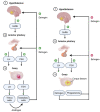An update on polycystic ovary syndrome: A review of the current state of knowledge in diagnosis, genetic etiology, and emerging treatment options
- PMID: 35972046
- PMCID: PMC9386861
- DOI: 10.1177/17455057221117966
An update on polycystic ovary syndrome: A review of the current state of knowledge in diagnosis, genetic etiology, and emerging treatment options
Abstract
Polycystic ovary syndrome is the most common endocrine disorder in women of reproductive age, which is still incurable. However, the symptoms can be successfully managed with proper medication and lifestyle interventions. Despite its prevalence, little is known about its etiology. In this review article, the up-to-date diagnostic features and parameters recommended on the grounds of evidence-based data and different guidelines are explored. The ambiguity and insufficiency of data when diagnosing adolescent women have been put under special focus. We look at some of the most recent research done to establish relationships between different gene polymorphisms with polycystic ovary syndrome in various populations along with the underestimated impact of environmental factors like endocrine-disrupting chemicals on the reproductive health of these women. Furthermore, the article concludes with existing treatments options and the scopes for advancement in the near future. Various therapies have been considered as potential treatment through multiple randomized controlled studies, and clinical trials conducted over the years are described in this article. Standard therapies ranging from metformin to newly found alternatives based on vitamin D and gut microbiota could shine some light and guidance toward a permanent cure for this female reproductive health issue in the future.
Keywords: etiology; polycystic ovary syndrome; polycystic ovary syndrome diagnosis; reproductive health; treatment options.
Conflict of interest statement
Figures




Similar articles
-
The role of metformin in the management of polycystic ovary syndrome.Curr Opin Obstet Gynecol. 2003 Dec;15(6):483-8. doi: 10.1097/00001703-200312000-00005. Curr Opin Obstet Gynecol. 2003. PMID: 14624214
-
Polycystic ovary syndrome update in adolescence.Curr Opin Pediatr. 2007 Aug;19(4):389-97. doi: 10.1097/MOP.0b013e328236743f. Curr Opin Pediatr. 2007. PMID: 17630601 Review.
-
AMERICAN ASSOCIATION OF CLINICAL ENDOCRINOLOGISTS, AMERICAN COLLEGE OF ENDOCRINOLOGY, AND ANDROGEN EXCESS AND PCOS SOCIETY DISEASE STATE CLINICAL REVIEW: GUIDE TO THE BEST PRACTICES IN THE EVALUATION AND TREATMENT OF POLYCYSTIC OVARY SYNDROME--PART 1.Endocr Pract. 2015 Nov;21(11):1291-300. doi: 10.4158/EP15748.DSC. Endocr Pract. 2015. PMID: 26509855
-
Is pharmacogenomics our future? Metformin, ovulation and polymorphism of the STK11 gene in polycystic ovary syndrome.Pharmacogenomics. 2008 Aug;9(8):1163-5. doi: 10.2217/14622416.9.8.1163. Pharmacogenomics. 2008. PMID: 18681789
-
Metformin and polycystic ovary syndrome.Curr Opin Endocrinol Diabetes Obes. 2007 Apr;14(2):132-40. doi: 10.1097/MED.0b013e328089f0ea. Curr Opin Endocrinol Diabetes Obes. 2007. PMID: 17940431 Review.
Cited by
-
The relationship between polycystic ovary syndrome and gynecological cancers: neurotransmitter metabolism changes and immune regulation.Front Immunol. 2025 Jun 4;16:1578470. doi: 10.3389/fimmu.2025.1578470. eCollection 2025. Front Immunol. 2025. PMID: 40534880 Free PMC article. Review.
-
The Pathophysiological Mechanism and Clinical Treatment of Polycystic Ovary Syndrome: A Molecular and Cellular Review of the Literature.Int J Mol Sci. 2024 Aug 20;25(16):9037. doi: 10.3390/ijms25169037. Int J Mol Sci. 2024. PMID: 39201722 Free PMC article. Review.
-
A policy brief on improving the lifestyle of women with polycystic ovary syndrome.Caspian J Intern Med. 2024 Winter;15(1):176-183. doi: 10.22088/cjim.15.1.21. Caspian J Intern Med. 2024. PMID: 38463925 Free PMC article.
-
Physiopathology of polycystic ovary syndrome in endocrinology, metabolism and inflammation.J Ovarian Res. 2025 Feb 20;18(1):34. doi: 10.1186/s13048-025-01621-6. J Ovarian Res. 2025. PMID: 39980043 Free PMC article. Review.
-
Multi-specialty Physician Preferences and Perceptions in Treatment and Management of Polycystic Ovary Syndrome in China: Survey and Discrete Choice Experiment.Adv Ther. 2025 Aug 8. doi: 10.1007/s12325-025-03311-7. Online ahead of print. Adv Ther. 2025. PMID: 40781501
References
-
- Azziz R, Carmina E, Chen Z, et al.. Polycystic ovary syndrome. Nat Rev Dis Primers 2016; 2: 16057. - PubMed
-
- Knochenhauer ES, Key TJ, Kahsar-Miller M, et al.. Prevalence of the polycystic ovary syndrome in unselected Black and White women of the southeastern United States: a prospective study. J Clin Endocrinol Metab 1998; 83(9): 3078–3082. - PubMed
-
- Dokras A, Saini S, Gibson-Helm M, et al.. Gaps in knowledge among physicians regarding diagnostic criteria and management of polycystic ovary syndrome. Fertil Steril 2017; 107(6): 1380–1386. - PubMed
-
- Witchel SF, Teede HJ, Peña AS. Curtailing PCOS. Pediatr Res 2020; 87(2): 353–361. - PubMed
-
- Azziz R, Marin C, Hoq L, et al.. Healthcare-related economic burden of the polycystic ovary syndrome during the reproductive life span. J Clin Endocrinol Metab 2005; 90(8): 4650–4658. - PubMed
Publication types
MeSH terms
Substances
LinkOut - more resources
Full Text Sources
Medical

